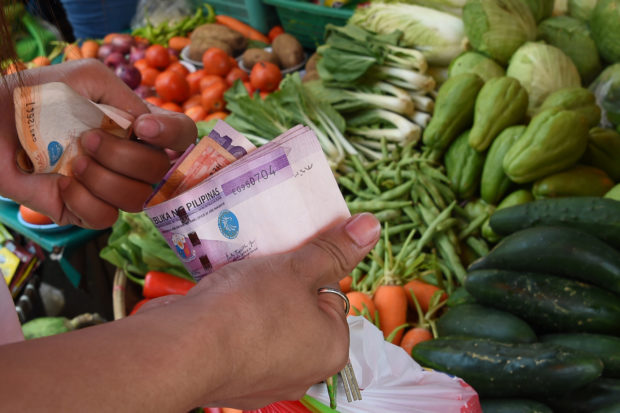June inflation eases but oil prices pose risk
While inflation eased in June to 4.1 percent year-on-year or the lowest monthly rate so far in 2021, the normalizing global oil prices pose upside risks in the second half and would likely keep overall price hikes above the central bank’s target.
National Statistician Dennis Mapa, in a press conference on Tuesday, attributed the lower rate of increases in the prices of basic commodities last month mainly to base effects as transport inflation slowed from a year ago, when tricycle and jeepney fares soared due to the stringent COVID-19 quarantine measures that limited both the supply of and demand for public transportation.
Transport inflation fell to 9.6 percent year-on-year in June from 16.5 percent in May.
Price hikes in tricycle and jeepney fares slowed to 17.6 percent and 4.3 percent, respectively, from May’s 38.8 percent and 6.3 percent.
Food prices
Socioeconomic Planning Secretary Karl Kendrick Chua said the lower June inflation was also a result of government interventions to bring down food prices, especially of pork, which soared early this year mainly due to the African swine fever (ASF) crisis. Data showed meat inflation slowed to 19.2 percent year-on-year last month from as high as 22.1 percent in April and May. Meat prices in June also declined by 0.3 percent compared to May levels.
No interest rate hike
The Bangko Sentral ng Pilipinas (BSP) said the June inflation reinforced its projection that the pace of price increases for basic goods and services would decline toward the end of the year.
In a statement, the BSP, however, said the consumer price index (CPI) would remain relatively high for now, with the June 2021 inflation of 4.1 percent being “consistent with expectations that inflation could remain above target in the near term as meat and oil prices remain elevated.”
The latest inflation rate was within the BSP’s forecast range of 3.9 to 4.7 percent.
“Average inflation is projected to settle at the high-end of the target range of 2 to 4 percent in 2021,” the central bank said. “However, price pressures are seen to abate leading to the reversion of average inflation near the midpoint of the target in 2022 to 2023.”
In the meantime, petroleum and fuels also posted lower inflation of 21.5 percent last month compared to the 33-percent jump in May.
But Mapa conceded that oil might be a “potential threat” to easing inflation as prices here and abroad continued to normalize alongside improving global economic prospects from last year’s pandemic-induced slump.
Mapa noted that while petroleum and fuels for personal consumption accounted for only 2 percent in the CPI basket of goods, last month’s price hike contributed 51.5 percent to the June headline inflation rate.
In a note to clients, Pantheon Macroeconomics senior Asia economist Miguel Chanco said that “favorable base effects in transport helped bring inflation down, but the third quarter has no such aid, and we reckon transport inflation will rise through the second half, thanks to oil price gains.”
“Housing and utilities inflation continued rising in June, but its contribution is set to pick up more substantially in coming months, given the lag in oil prices. Similarly, food inflation made a stable contribution of 1.8 percentage point (ppt) to the headline in June, but global food price trends point to a rise, despite government supply-side efforts to prevent that,” Chanco said.
As such, Chanco projected inflation would “move further away” from the upper end of the Bangko Sentral ng Pilipinas’ (BSP) 2-4 percent target range in the second half. Headline inflation averaged an above-target 4.4 percent in the first half.
Chanco said slow economic recovery would prevent the BSP from hiking interest rates, especially as “herd immunity is still a long way away unlike other Asean countries, due to slow vaccinations and one of the region’s highest rates of vaccine hesitancy.”
In a statement, the state planning agency National Economic and Development Authority (Neda) said “the costs of transport services remain elevated primarily because of social distancing measures and the recovery of global oil prices” even as fares would “partially decrease in the near term with the government’s accelerated vaccination program.”
“Keeping transport expenses low complements our efforts to safely bring people to their workplaces. We are accelerating the vaccination of the A4 priority group of workers to keep them and their families protected as they earn a living. These efforts will help the economy recover strongly in 2021,” Socioeconomic Planning Secretary Karl Kendrick Chua said.
Inflation among poor families belonging to the bottom 30-percent income households, meanwhile, eased to 4.3 percent in June — also the lowest monthly rate so far this year yet still higher than the headline figure, which meant they shelled out more money for their basic necessities.
Mapa said inflation among the country’s poorest households eased also on the back of slower increases in transport costs as well as prices of alcoholic beverages and tobacco.
According to the BSP, the effective implementation of direct non-monetary measures will be crucial in mitigating further supply-side pressures, adding that the risks to the inflation outlook also “remain broadly balanced.”
“The uptick in international commodity prices owing to supply-chain bottlenecks and the recovery in global demand could lend upward pressures on inflation,” it said. “However, downside risks to the inflation outlook continue to emanate from the emergence of new coronavirus variants, which could delay the easing of lockdown measures and temper prospects for domestic growth.”

